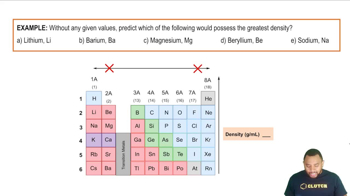Textbook Question
Write the molecular and structural formulas for the compounds represented by the following models:
 Verified step by step guidance
Verified step by step guidance



Write the molecular and structural formulas for the compounds represented by the following models:
Fill in the gaps in the following table: Symbol 59Co3+ Protons 34 76 80 Neutrons 46 116 120 Electrons 36 78 Net charge 2+
Fill in the gaps in the following table: Symbol 133Cs+ Protons 35 15 Neutrons 46 16 30 Electrons 18 20 Net charge 1- 5+
Using the periodic table, predict the charge of the most stable ion of the following elements: (a) Li (b) Ba (c) Po (d) I
Using the periodic table, predict the charge of the most stable ion of the following elements: (e) Sb.
Using the periodic table to guide you, predict the chemical formula and name of the compound formed by the following elements: (a) Ga and F (b) Li and H